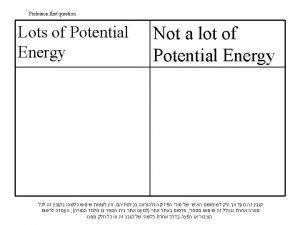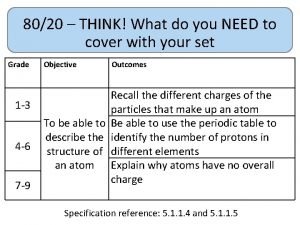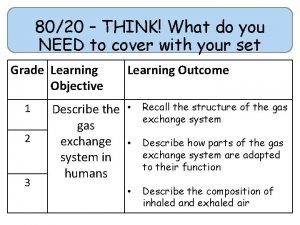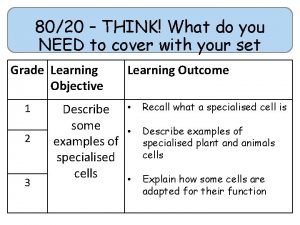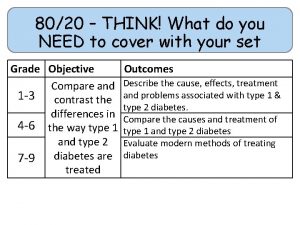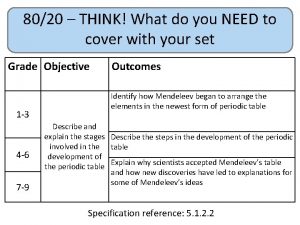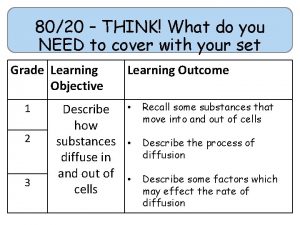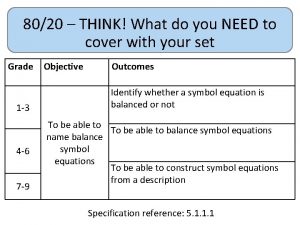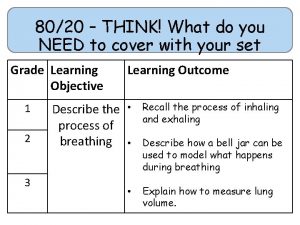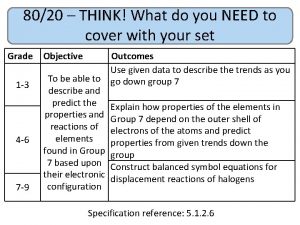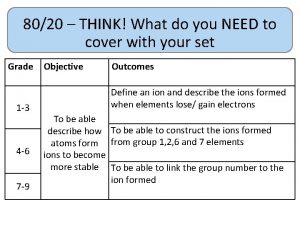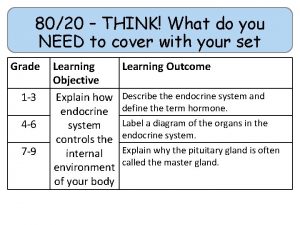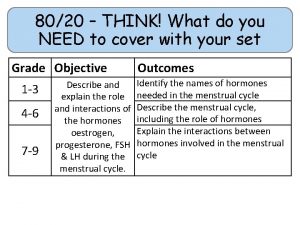8020 THINK What do you NEED to cover















- Slides: 15

80/20 – THINK! What do you NEED to cover with your set Grade Learning Objective 1 2 3 Describe the difference between unicellular and multicellular organisms Learning Outcome • Recall what a unicellular organism is • Describe the structure of an amoeba • Describe the structure of a euglena

Unicellular Organisms Do now activity: What is the smallest organism that you can think of, which lives in our environment?

Progress indicators GOOD PROGRESS: • Recall what a unicellular organism is • Describe the structure of an amoeba OUTSTANDING PROGRESS: • Describe the structure of a euglena

Amoeba and euglena are both types of unicellular organism http: //www. youtube. com/watch? v=7 p. R 7 TNz. J_p. A

Unicellular Organisms Task 1: Draw and label a diagram of both an amoeba and euglena. Task 2: Describe the diet of each organism and explain how both the amoeba and euglena reproduce. Use the information on Slide 6 and 7 to complete the task on slide 8

Amoeba An amoeba is a unicellular organism that has no fixed shape, they can move by changing the shape of their body. Pseudopod Nucleus Food Vacuole Cell membrane Contractile Vacuole Amoebas look a bit like a blob of jelly, they can be found in fresh water, wet soil and even inside animals. They eat algae, bacteria and plant cells. They can engulf food by surrounding the tiny particles of food with their cytoplasm, then forming a food vacuole. Chemicals in the food vacuole digest the food. They reproduce by a process called binary fission – this means the amoeba cell splits itself into two by firstly the nucleus dividing, then the cytoplasm – producing two identical daughter cells.

Euglena An euglena is a unicellular organism that is found in freshwater. Flagellum Eye spot Chloroplast Nucleus Contractile Vacuole Euglenas are similar to amoeba in that they contain cytoplasm and a nucleus, but they also have chloroplasts, which make them look green. The chloroplasts trap energy transferred from the Sun so that the euglenas can make food by photosynthesis. They have an eye spot which detects light, also a flagellum to help them swim towards the light. If euglena is unable to utilize light to produce food it will eat other small microorganisms, such as bacteria and algae. Euglenas also reproduce by binary fission, the same as ameobas.


Self-assessment:

Self-assessment: Amoebas eat algae, bacteria and plant cells. They can engulf food by surrounding the tiny particles of food with their cytoplasm, then forming a food vacuole. Chemicals in the food vacuole digest the food. They reproduce by a process called binary fission – this means the amoeba cell splits itself into two by firstly the nucleus dividing, then the cytoplasm – producing two identical daughter cells. If euglena is unable to utilize light to produce food it will eat other small microorganisms, such as bacteria and algae. Euglenas also reproduce by binary fission, the same as amoeba’s.

Task: Copy and complete the sentences using the following key words: Binary fission one unicellular engulf Amoebas and euglenas are examples of _____ organisms. This means that they are only made up of ______ cell. Both organisms reproduce by ______. Amoebas have to _____ food to survive but euglenas can carry out _____ to produce their own food. photosynthesis

Self-assessment: Amoebas and euglenas are examples of unicellular organisms. This means that they are only made up of one cell. Both organisms reproduce by binary fission. Amoebas have to engulf food to survive but euglenas can carry out photosynthesis to produce their own food.

Key Word Bingo!! 1. Choose 6 of the following words/terms and write them into your books: 1. Diffusion 2. Microscope 3. Nucleus 4. Red blood cell 5. Root hair cells 6. Cell membrane 7. Stage 8. Sperm cell 9. Concentration 10. Euglena 2. I am going to read a definition, if it matches one of the words/terms you have written down then cross it out. 3. The first person to cross all 6 of their words out, shout BINGO!!!

3 -3 -1 Reduction 3 facts 3 key words 1 key words

Resources
 Iso 8020
Iso 8020 Ramaniklal ambani
Ramaniklal ambani If you think you can you can poem
If you think you can you can poem Heterophoria vs heterotropia
Heterophoria vs heterotropia Alternate prism cover test
Alternate prism cover test Krimsky and modified krimsky test
Krimsky and modified krimsky test Wish you all the strength
Wish you all the strength Split speech example
Split speech example Why according to robin and jay are people funny
Why according to robin and jay are people funny Think fam think
Think fam think Have a daughter so you can argue
Have a daughter so you can argue Choose the correct answer a-c
Choose the correct answer a-c So you think you can argue
So you think you can argue You know minecraft
You know minecraft What do you think of when you hear the word family
What do you think of when you hear the word family You have more potential than you think
You have more potential than you think















